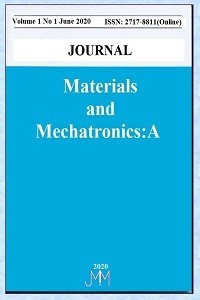54SiCr6 ve 60SiMn5 Yay Çeliklerinin Isıl İşlemi ve Mikroyapısal Analizi
Dünya üzerinde en fazla kullanılan alaşım olan çelik, malzeme biliminin en net işlevi olan malzemelerdeki yapı-özellik-performans ilişkisinin incelenmesinde en somut örnektir. Çelikler katı çözeltide başka bir element atomlarıyla buluşmasıyla çok farklı özellikler sergilemektedir bu özellik değişimlerine bağlı olarak ise kullanıldığı alanda malzemenin performansını belirlemektedir. Silisyum elementi çeliklere belirli oranlarda eklendiğinde endüstride çeliğin yay çeliği olarak kullanılmasında gerekli mekanik özellikleri sağlamakta önem taşır ve genelde bu çelikler silisyum yay çelikleri olarak sınıflandırılır. Çeliklerin kimyasal karakterin dışında özellik ve performanslarını belirlemek, düzenlemek ve geliştirmek için ısıl işlemler uygulanır. Bu ısıl işlemler farklı amaçlarla farklı yöntemlerle yapılmaktadır. Bu çalışmada, silisyum içeren yay çeliklerinin üretildiğinde sahip olduğu sertliğin daha sonra ani soğutmada, soğutma ortamı olarak su kullanıldığında veya yağ kullanıldığında nasıl tepki verdiği sertleştirme işlemi akabinde temperleme ile nihai sertlik ve iç yapıları incelenmiştir. Sonuçlar göstermiştir ki, su verme işleminden sonra, 54SiCr6 çeliği, tam martenzitik 60MnSi5 çeliğine göre, martenzit+beynit yapısında mikroyapı üretilmiştir.
Anahtar Kelimeler:
54SiCr6 Çeliği, 60SiMn5 Çeliği, Isıl işlem, Mikroyapı
Heat Treatment and Microstructural Analysis of 54SiCr6 and 60SiMn5 Spring Steels
Steels, the most widely used alloy in the world, are the most concrete example in the study of the structure-property-performance relationship in materials, which is the clearest function of the science of materials. Steels exhibit very different properties when other types of atom are present in the solid solution. Due to these changes in properties, the performance of the material in the area of use is determined. When silicon is added to steels in certain proportions, it is important to provide the necessary mechanical properties in steel industry as spring steel, and these steels are generally classified as silicon spring steels. Heat treatments are applied to determine, regulate and improve the properties and performances of steels other than their chemical properties. These heat treatments are carried out with different methods for different purposes. In this study, the hardness of silicon containing spring steels when it is produced, then how hard it reacts in sudden cooling, when water or oil is used as cooling medium, the final hardness and microstructures are examined by tempering followed by hardening. Results showed that 54SiCr6 produced martensite+bainite structure as opposed to fully martensitic 60SiMn5 specimen after quenching process.
Keywords:
54SiCr6 Steels, 60SiMn5 Steels, Heat treatment, Microstructure,
___
- Canale, L.C.F. and Penha, R.N., Overview of factors contributing to steel spring performance and failure. International Journal of Microstructure and Materials Properties, 2(3/4), 2007.
- Çalik, A. Effect of cooling rate on hardness and microstructure of AISI 1020, AISI 1040 and AISI 1060 Steels. International Journal of Physical Sciences, 4, 514-518, 2009.
- Dindar, Ç, Beytut, H. and Karagöz, S., Effect of Heat Treatment and Cross Section on The Crashworthiness of 51CrV4 Spring Steel. Uludağ University Journal of the Faculty of Engineering, 24(2), 477-488, 2019.
- Ghosh, G.and Olson, G.B. Kinetics of fcc-bcc heterogeneous martensitic nucleation - II. Thermal activation. Acta Metallurgica Materialia, 42(10), 3371, 1994.
- Kitahara, H., Ueji, R., Tsuji, N., Minamino, Y. Crystallographic features of lath Martensite in low-carbon steel. Acta Materialia, 54, 1279-1288, 2006.
- Liu, Y.C., Sommer, F. and Mittemeijer, E.J. Abnormal austenite-ferrite transformation behaviour in substitutional Fe-based alloys. Acta Materialia, 51, 507-519, 2003.
- Loewy, S., Rheingans, B., Meka, S.R. and Mittemeijer, E.J. Unusual martensite-formation kinetics in steels: Observation of discontinuous transformation rates. Acta Materialia, 64, 93, 2014.
- Machado, I.F., Technological advances in steels heat treatment. Journal of Materials Processing Technology, 172, 169-173, 2006.
- Mesplont, C., Phase transformations and microstructure-mechanical properties relations in complex phase high strength steels, University of Lille, 2002.
- Morito, S., Huang, X., Furuhara, T., Maki, T. and Hansen, N., The morphology and crystallography of lath martensite in alloy steels. Acta Materialia, 54, 5323-5331, 2006.
- Morito, S., Adachi, Y. and Ohba, T., Morphology and crystallography of sub-blocks in ultra-low carbon lath martensite steel, Materials Transactions, 50(8), 1919–1923, 2009.
- Morito, S., Tanaka, H., Konishi, R., Furuhara, T and Maki, T., The morphology and crystallography of lath martensite in Fe-C alloys, Acta Materialia, 51(6), 1789–1799, 2003.
- Mudasiru, L.O., Babatunde, I.A., Raheem, W.A., Lasisi, A.K., Effect of immersion speed on the mechanical properties and microstructure of oil quenched AISI 1020 steel. Journal of Engineering and Technological Research, 6, 68-74, 2014.
- Razzak, M.A., Heat treatment and effects of Cr and Ni in low alloy steel. Bulletin of Materials Science, 34(7), 1439-1445, 2011.
- Rehrla, C., Kleberb, S., Renka, O. and Pippan, R., Effect of grain size in compression deformation on the microstructural evolution of an austenitic stainless steel. Materials Science and Engineering: A, 540, 55-62, 2012.
- Senthilkumar, T., Ajiboye, T.K., Effect of heat treatment processes on the mechanical properties of medium carbon steel. Journal of Minerals & Materials Characterization & Engineering, 11, 143-152, 2012.
- Stormvinter, A., Borgenstam, A. and Hedstrom, P., Investigation of lath and plate martensite in a carbon steel, Solid State Phenomena, 172, 61-66, 2011.
- Tsuzaki, K. and Maki, T., The effect of cooling rate on the morphology of lath martensite in Fe-Ni alloys. Journal of Japan Institute of Metals, 45, 126, 1981.
- Villa, M., Pantleon, K., Reich, M., Kessler, O. and Somers, M.A.J., Kinetics of anomalous multi-step formation of lath martensite in steel. Acta Materialia, 80, 468-477, 2014.
- Villa, M., Hansen, M.F., Pantleon, K. and Somers, M.A.J., Thermally activated growth of lath martensite in Fe-Cr-Ni-Al precipitation hardenable stainless steel. Materials Science and Technology, 31, 115-122, 2015.
- Wang, J., Van der Wolk, P.J., Van der Zwaag, S., Determination of Martensite Start Temperature in Engineering Steels Part I. Empirical Relations Describing the Effect of Steel Chemistry, Materials Transactions JIM, 41, 761-768, 2000.
- Weidner, A., Segel, C., Biermann, H., Magnitude of shear of deformation-induced α’ martensite in high-alloy metastable steel, Materials Letters, 143, 155-158, 2015.
- Yayın Aralığı: Yılda 2 Sayı
- Başlangıç: 2020
- Yayıncı: Yusuf KAYALI
